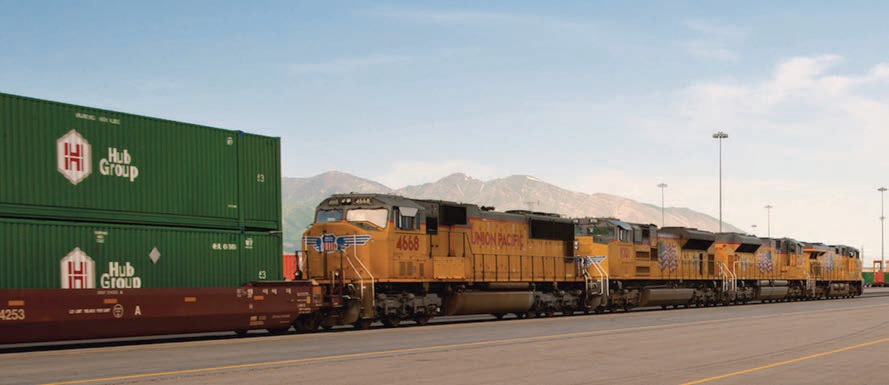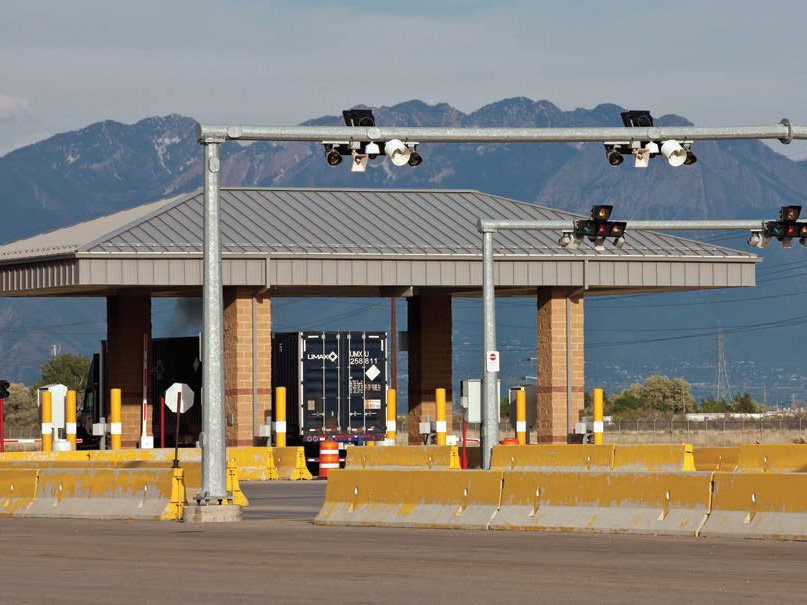The Utah Inland Port Authority, better known as the UIPA, is engaged in building a unique and ambitious intermodal network that could restructure freight movements for nearly a quarter of the country. It is a project that has had its share of setbacks, but this revitalized plan could set the bar for the future of freight multimodalism in the U.S.

After the ambitious concept of a single, giant centralized logistics-driven transloading terminal for landlocked Utah didn’t fly, new leadership for the Utah Inland Port Authority (UIPA) shifted gears and is creating smaller multimodal rural hubs statewide where truck, rail and even air shippers can capitalize on the massive capacity of the emission-free Union Pacific Railroad.
What could be a first coordinated logistical effort to get trucks off the highways in the US and simultaneously strengthen the economy of a state known for its collaborative spirit and productivity, the five- year-old UIPA already has three supply chain “projects” or potential “railports” identified and one is operational, transporting American manufactured steel by truck and transshipping it by rail to destination.
The Beehive state is busy at work on a fourth project hub likely to be approved and launched in late August. It is no surprise the UIPA’s mission of streamlining the moving goods is a priority. Last year the state-owned port authority said that one-third of Utah’s GDP, employment, and incomes are dependent on the logistics system, one that is beset nationwide with problems ranging from highway congestion, outdated infrastructure, labor shortages, environmental pollution and manufacturing fleeing overseas.
In addition to on-site multimodal transshipping, each rural project will have a foreign trade zone where localized, tax-advantaged manufacturing can be conducted with the goal of creating new jobs and even a residential component to house administrative personnel and production workers.
A New Look and Revised Mission
Heading the UIPA and chief architect of its revised strategic plan is Ben Hart, executive director, and chief executive officer who, interestingly, does not have a dedicated logistics or transportation background. He was previously deputy director of Utah governor Spencer J. Cox’s Office of Economic Development. Hart replaced Jack Hedge who retired last year and guided the state agency for three years during its start-up/ramp-up development phase. Hedge had previously held a senior executive post with Port of Los Angeles and is credited with creating relationships for UIPA with coastal ports, the Federal Maritime Administration, the national freight rail system, and numerous ocean carriers.
Since taking UIPA’s reins in 2022, Hart has moved quickly to put his stamp on the agency. For starters, he has rebranded it with a new logo that visually communicates its mission as a multidisciplinary, multimodal logistical force that leverages Utah’s geographical location in the US.
“We are the crossroads of the West from a distribution standpoint,” he told the American Journal of Transportation in an exclusive interview. “We’ve got I-80, I-70 and I-15 so rather than focus on just one location in the state, it has to be statewide network of regional inland ports. But that doesn’t mean they have to be small because significant large-scale terminals are still being considered. It’s just not a single big facility.”

Hart says when UIPA was formed, the original agreements with several coastal ports were more strategic alliances to ship truck and rail traffic to and from the ports of Oakland, Los Angeles, and Long Beach. “Now we’re trying to broaden our established partnerships with new ports such as Pacific Northwest ports where Union Pacific has rail service and Texas where the UP has an expedited intermodal service. The Union Pacific is our Class One rail service provider in Utah and our key partner. Our job at UIPA is to make sure that we pull more (truck) volume onto rail by giving good service and good prices, so we have to work together.”
Still, the UIPA’s goal is not just expedited freight transportation. “We want,” he adds, “to harmonize logistics and manufacturing to maximize long-term economic benefits to the area to fit the needs of the region.”
Iron Springs Project
It’s already happening in the Southwestern corner of Utah, some 275 miles from Salt Lake City, in what is called the Iron Springs Project Area. There, in Cedar City, Building Zone Industries (BZI) and its affiliate company, RailSync, is delivering railcars of raw materials—steel and lumber—to local companies. “Our new vertically integrated transloading service, RailSync, is operating and open for business and is set to bring significant and economic business impact to Southern Utah,” Guy Nielsen, RailSync’s chief operating officer, said in a statement that also noted it’s a more “efficient and sustainable way to transport steel.”
Commerce Crossroads, a new 820-acre sustainable industrial park and transportation hub built in partnership with the Utah Inland Port Authority (UIPA), establishes the first rural inland port in the state of Utah. BZI Chief Marketing Officer Spencer Douglas, told the American Journal of Transportation, “The Industrial park’s integrated offerings will improve the transporting and processing of goods and products for a variety of companies and are expected to bring more jobs with higher wages and economic opportunities to the region. The Commerce Crossroads complex will include enhanced technology, construction material manufacturing, steel fabrication, data centers, e-commerce, and distribution, as well as office space and residential housing available to its customers.”
Commerce Crossroads is situated in the Northwest corner of Iron County, Utah. Noted Douglas, “This area is often referred to as ‘The Crossroads of the West,’ due to its central location, which is only a day’s drive from population centers like LA, Denver, Phoenix, and Salt Lake City, and allows access to a potential market of 48+ million people.” VISCO, a BZI affiliated general contractor, will be available for build-to-suit contracting services, among others in the park.

RailSync, the first tenant of Commerce Crossroads, is a new rail transloading service and hub providing integrated offerings for the streamlined transportation of raw materials. It is expected to attract global businesses to Cedar City and the Southern Utah region. RailSync will eventually provide expanded short-line rail service to individual facilities located in Commerce Crossroads. Guy Nielsen, COO of RailSync stated, “Our new vertically integrated transloading service is operating and open for business and is set to bring significant economic and business impact to Southern Utah.” Nielsen added, “RailSync will make it much easier for businesses in the area to access the resources they need. This, in turn, will lead to increased productivity and efficiency, and ultimately boost the local economy.”
One of RailSync’s first users recognizes the differentiated approach to the company’s innovative transportation offerings. “We are thrilled to have a more accessible, sustainable, and efficient means to transport steel,” said Sam Williams, COO of BZI Steel™. “Less truck loads and more rail loads are better for the environment and ensure a more direct and efficient form of delivery, allowing us to enhance our level of service to our customers.”
“Before RailSync, the only transloading points were in Salt Lake City, Phoenix, Las Vegas or Los Angeles. There are 48 million people within an eight to ten hour drive of RailSync in Cedar City that we can serve. Someday, this will be a bustling railport.”
Meanwhile, he claims BZI has seen a large financial savings and reduced pollution in the short time RailSync has been operating. “Every one of the train cars full of steel is equal to four semi truckloads of steel. So, when you have seven railcars of steel coming through, that’s the equivalent of 30 truckloads for the same volume of steel that are not on the road. In our first month of operation, we saved approximately $75,000 from trucks that did not have to come here from (a transloading center in) Salt Lake City or Phoenix.”
BZI and RailSync are not alone in the Iron County Project. Savage Companies of Salt Lake City, a 77 year-old supply chain and infrastructure solutions provider is building a 74-acre railport and terminal near Cedar City to provide transloading services for “agricultural products, construction materials and other essential commodities,” says Jeff Hymas, public affairs director. The venture will include an office building, transload equipment and four rail spurs off the Union Pacific’s mainline that can hold a total of 100 railcars.
Savage is no rookie when it comes to this type of facility. It operates 50 transloading terminals in North America including one in Tooele, Utah serving businesses on the Wasatch Front. Its Iron County railport is expected to be operational in the second quarter of 2024. Additionally, Savage won a separate assignment from the state as a rail consultant for the UIPA to assist with statewide infrastructure planning, design reviews and advising on rail and supply chain issues.
The company is well connected. Armando Tirado, its vice president and unit leader for rail and terminals west, was previously director of transportation services for a decade with the Union Pacific Railroad. “Utah does not have a direct line between the railroad’s mainline and the community for shipping inbound and outbound goods, but it has a unique culture of collaboration and UIPA’s new administration chose to diversify to satellite rural railports from its previous grand scheme of a single terminal,” he says. The game plan is to get the supply chain closer to the manufacturing facilities which is a “collaborative win-win solution” for Utah’s multi-generational citizenry, he adds.

Salt Lake’s Northwest Quadrant Project
The original UIPA railport is currently called the Northwest Quadrant in Salt Lake City, a sprawling 16,000 acre project near the Union Pacific’s huge, existing transshipment terminal. It does not have an operator yet. But it is on the UP’s main rail line and will be served by several short lines including Patriot Rail and Utah Railway. This was originally to be the state’s lone transshipment point back when UIPA was planned but the project met with considerable resistance which led to the switchover to strategically located rural locations.
According to Hart, the Northwest Quadrant location was chosen to “attract the best and the brightest manufacturers for the site” and that goal has not changed. He contends the vast acreage and its close proximity to the Salt Lake City International Airport plus Utah’s well-publicized reputation for worker productivity and close private-public collaboration will eventually appeal to the target manufacturers the state is seeking. However, he is confident the rural projects will attract similar manufacturers, as well.
The third inland rural railport already identified is the 800-acre Verk Industrial Park Project Area in Spanish Fork, Utah that will be located close to both I-15 and US 6 highways. It’s strategically situated in the north-central part of the state and is on the Union Pacific mainline and adjacent to a general aviation municipal airport.
“It’s right at the edge of the Wasatch Front and creates a really unique opportunity to help capture more traffic or convert trucks to rail. But I think it also gives access to a lot of shippers in the Utah County community, says Hart. “With a strong base of exporters and importers for Utah, this will also help us open shipping corridors to ports we haven’t worked with before such as in the Pacific Northwest.”
Not so coincidentally, the Wasatch Front has a steep history of railroading. The first transcontinental railroad, with roots going back to the Union Pacific, ran through the region with tracks reaching the city of Ogdon in 1869. In recent years, the area has had a very strong population growth and is presently the state’s fastest growing county.
Job creation statewide is a prime objective of the UIPA’s revised plan of inland satellite railports. Verk will “bring 6,000 to 8,000 much-needed new jobs to the area,” Hart forecasts. Elsewhere, Iron County’s proposed railport should generate 4,000 jobs, Spanish Fork 3,000 to 4,000 jobs, Northwest Quadrant 30,000 to 40,000 jobs and the fourth inland railport, Box Elder County, also in the northern part of the state, 2,000 jobs, he adds. (Box Elder County is also where the Union Pacific and the Central Pacific railroads joined their tracks to link the nation).
With its focus on collaboration, the UIPA is helping potential inland railport operators and manufacturers with infrastructure financing. On April 23, a new Loan Approval Committee was installed, staffed with senior state government officials. The bi-partisan committee has the support of both the president of the Utah Senate and the Speaker of the House of Representatives. Local opposition to the UIPA’s newly focused satellite-based inland railport expansion plan is reduced compared to the first large single terminal strategy. One knowledgeable source describes opponents as “anti-growthers” and vocal “environmentalists.”
Multimodalism is the Backbone of the Strategy
Multimodalism is the backbone of the new UIPA regional strategy and Salt Lake City International Airport, again with its proximity to the planned Northwest Quadrant railport, will play a role in helping get big rig trucks off the state highways, Bill Wyatt, SLC’s airport director, told the American Journal of Transportation. The Union Pacific’s mainline is at the southern tip of the airport, he notes.
“They’re all our neighbors,” he adds. SLC is aggressively courting air cargo. It currently serves UPS, Fed Ex and DHL freighters and handles belly capacity from various combi carriers including Delta which uses the airport as a hub and accounts for 70% of its traffic. Wyatt and his team are courting international freighter operators. He was previously executive director of Port of Portland for 16 years which includes Portland International Airport and landed Cathay Pacific’s transpac flights.
Most of the air cargo today arrives and leaves SLC International by truck. “But we are working with freight forwarders to identify beneficial cargo owners to introduce them to our larger brand new (two year old) airport with our rail line and great access,” he says. “We are geographically well positioned to handle new and bigger air cargoes” that are appealing to the railroads.
Ironically, while the Union Pacific has long dominated Utah’s rail transportation, only 10% of the Beehive state’s cargo moves by rail, according to a UP spokeswoman at its Omaha, Nebraska headquarters. Yet it owns and operates the massive UP Salt Lake City Intermodal Terminal (SLCIT), so it has plenty of capacity to utilize. “This initiative (UIPA’s satellite strategy) aims to provide consistent, reliable movement of cargo on rail that improves fluidity and reduces shipment delays already set to come to the intermountain region rather than increase cargo volume,” says the spokeswoman.
However, by telling its freshly revised story and selling an intermodal supply chain solution, UIPA is clearly a catalyst in generating new cargo volume for the Union Pacific. A major component of that story is pure economics that has environmental benefits.
Sums up the UP’s spokeswoman: “Trains are the most fuel-efficient way to transport large quantities of goods and supplies, while reducing greenhouse gas emissions up to 75% compared to trucks. Loading 100 intermodal railcars equates to taking about 300 trucks off the road.”






